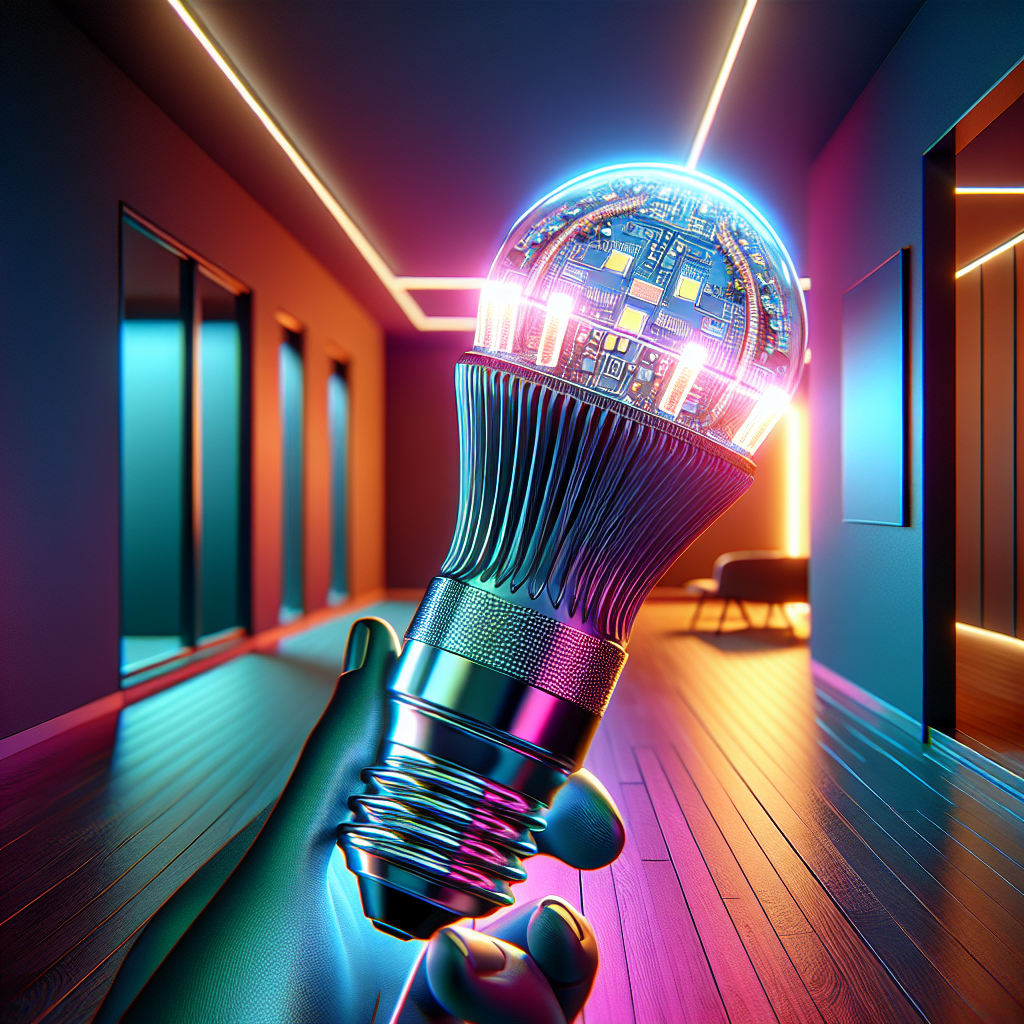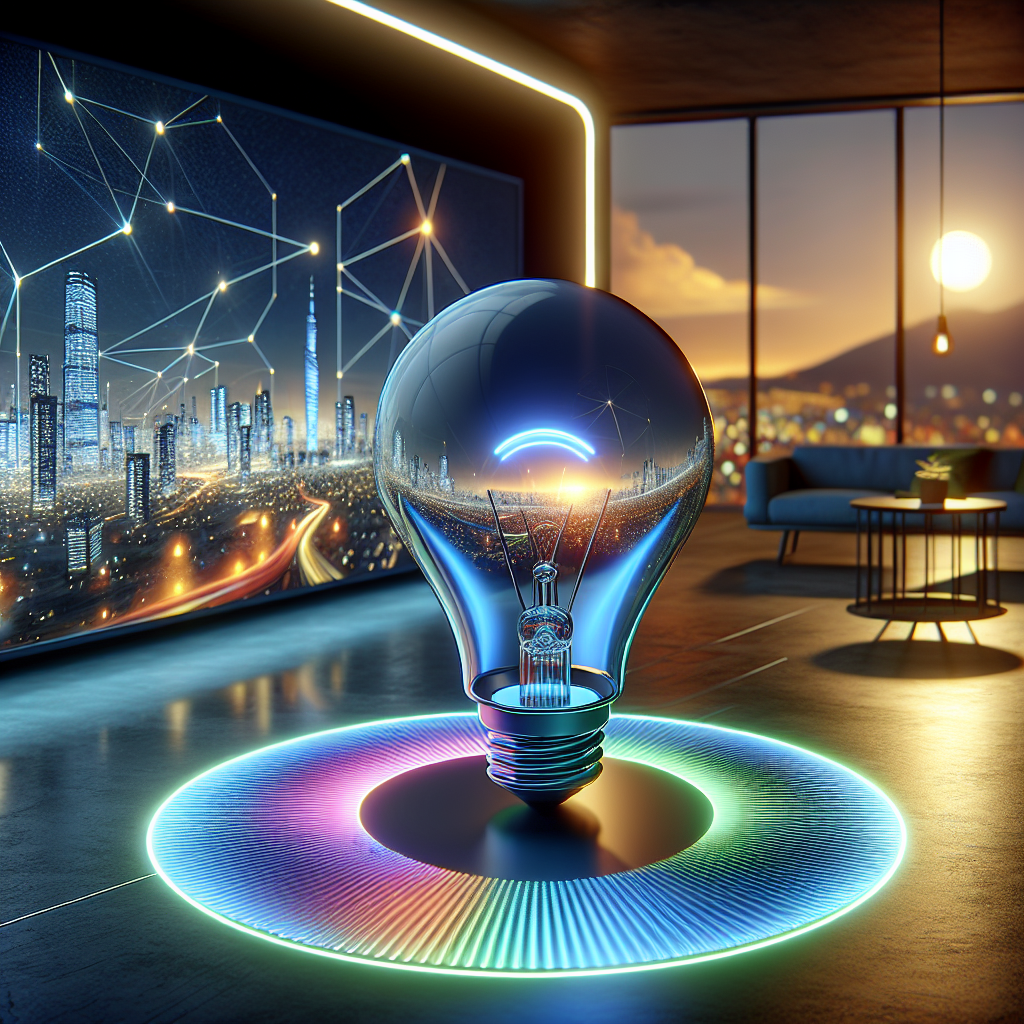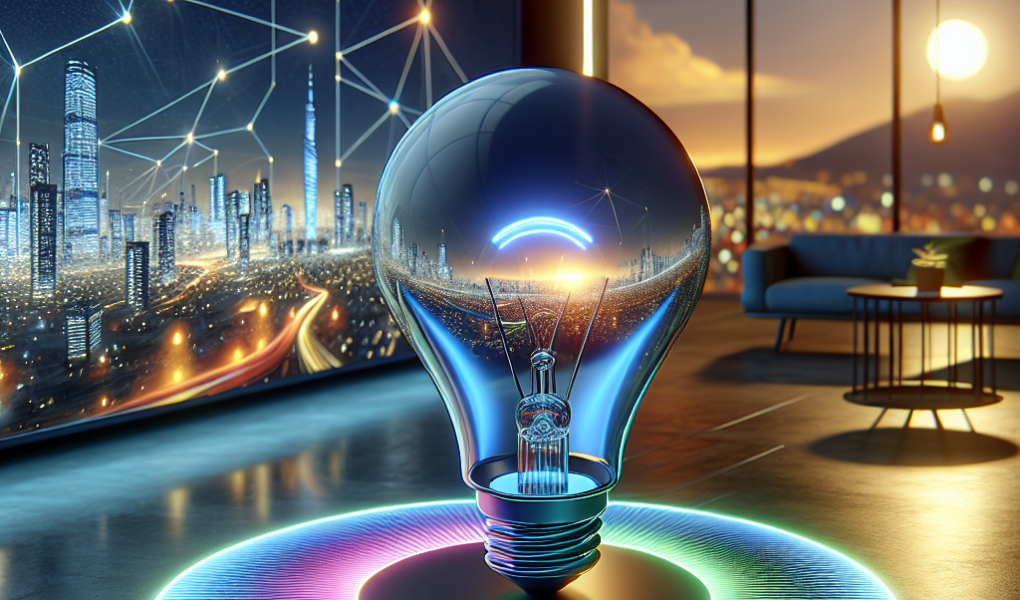In this article, we will explore the exciting world of emerging lighting trends for the future, specifically focusing on the year 2023. Get ready to discover the latest innovations and designs in the world of lighting that are set to transform our living spaces, enhance our well-being, and revolutionize the way we use light in our daily lives. From sustainable and energy-efficient lighting solutions to futuristic smart home integration, this article will illuminate the path towards the future of lighting. So, let’s embark on this enlightening journey together and see what the future holds for lighting!
Smart Lighting
Integration with IoT devices
Smart lighting technology has made significant advancements in recent years, and one of the most notable trends is its integration with Internet of Things (IoT) devices. This integration allows for seamless control and automation of lighting systems through connected devices such as smartphones, tablets, and voice assistants. By connecting your lights to the IoT, you can easily create schedules, set timers, and adjust the brightness or color of your lights with just a few taps or voice commands. This level of convenience and control makes smart lighting a valuable addition to any modern home or office.
Voice control capabilities
Gone are the days of manually flipping switches or adjusting dimmer knobs. With the rising popularity of voice assistants like Amazon Alexa and Google Assistant, smart lighting systems now come equipped with voice control capabilities. You can simply say phrases like “Hey Alexa, turn on the living room lights” or “Ok Google, dim the bedroom lights to 50%” to effortlessly control your lighting. This hands-free experience not only adds convenience but also enhances accessibility for individuals with mobility restrictions. With voice control, you can transform your space with just your words.
Adaptive lighting systems
Adaptive lighting systems are revolutionizing the way we experience light. These systems use sensors and algorithms to automatically adjust the intensity, color, and direction of light based on the environment, time of day, or user preferences. For instance, during daylight hours, the system can automatically dim the lights to conserve energy and reduce glare. In the evening, it can simulate the warm hues of sunset to create a relaxing ambiance. Adaptive lighting not only enhances comfort and convenience but also promotes energy efficiency by optimizing light output to match specific situations.
Energy Efficiency

LED technology advancements
Light-emitting diode (LED) technology has come a long way since its inception. These energy-efficient light sources have become the go-to option for both residential and commercial spaces. LEDs consume less energy than traditional incandescent bulbs and have a much longer lifespan. Furthermore, advancements in LED technology have led to improved color accuracy, brightness, and dimming capabilities, making them a versatile choice for various lighting applications. By transitioning to LED lighting, you can significantly reduce your energy consumption and contribute to a greener future.
Smart energy management systems
To further enhance energy efficiency, smart lighting systems often integrate with smart energy management systems. These systems allow you to monitor and optimize your energy usage by providing real-time data on your lighting consumption. With this information, you can identify energy-hungry areas and implement smart strategies like scheduling lights to turn off when not in use or dimming lights during peak energy demand periods. Smart energy management systems provide actionable insights, allowing you to make informed decisions and maximize energy savings without sacrificing comfort or convenience.
Lighting controls and sensors
Lighting controls and sensors play a crucial role in energy efficiency. Occupancy sensors, for example, detect motion and automatically turn lights on or off based on occupancy. This feature eliminates the need for manual switches and ensures that lights are only illuminated when needed. Additionally, daylight sensors detect natural light levels and adjust artificial lighting accordingly to maintain a desired illuminance level. By incorporating these controls and sensors into your lighting system, you can minimize energy waste, reduce electricity costs, and create a more sustainable environment.
Human-Centric Lighting

Circadian rhythm lighting
Circadian rhythm lighting aims to recreate the natural light cycles that regulate our internal clocks. It involves dynamically adjusting the color temperature and intensity of light throughout the day to align with our body’s natural circadian rhythms. The implementation of circadian lighting can have significant impacts on our overall health and well-being, improving sleep quality, enhancing mood, and increasing productivity. By mimicking natural daylight patterns, circadian rhythm lighting promotes a more harmonious connection between our built environment and our biological needs.
Tunable white lighting
Tunable white lighting allows users to control the color temperature of their lights, ranging from warm, cozy tones to cool, energizing hues. This flexibility is particularly beneficial in spaces where different activities take place, such as offices, classrooms, or healthcare facilities. Tunable white lighting can be adjusted throughout the day to complement the specific tasks or desired atmosphere. For instance, a cooler color temperature can promote focus and alertness during working hours, while a warmer temperature can create a calming and inviting environment for relaxation or socializing.
Biophilic design elements
Biophilic design is an approach that incorporates elements of nature into the built environment. When it comes to lighting, biophilic design focuses on creating a connection to the outdoors through the strategic use of natural light, views of nature, and even simulated natural lighting conditions. By integrating biophilic design elements into lighting fixtures and systems, we can enhance the visual and emotional experience of indoor spaces, promote stress reduction, and improve overall well-being. With biophilic lighting, you can bring the outdoors in and create a serene and inviting atmosphere.
Li-Fi Technology

High-speed data transmission
Li-Fi, or Light Fidelity, is a wireless communication technology that enables high-speed data transmission using light waves. Unlike traditional Wi-Fi, which relies on radio frequency signals, Li-Fi utilizes the visible light spectrum to transmit data. This technology has the potential to revolutionize data communication by offering faster and more secure connections. With Li-Fi, you can enjoy lightning-fast internet speeds without the need for cables or RF signals, making it a promising solution for environments where wireless connectivity is critical, such as hospitals, shopping malls, or smart homes.
Secure wireless communication
One of the major advantages of Li-Fi technology is its inherent security. Since light waves cannot pass through walls or obstacles, Li-Fi offers a more secure wireless communication method compared to Wi-Fi. This characteristic makes it particularly suitable for environments where data privacy is paramount, such as government facilities or financial institutions. With Li-Fi, you can enjoy the benefits of wireless connectivity while minimizing the risk of unauthorized access or signal interference.
Reduced electromagnetic interference
In today’s interconnected world, electromagnetic interference (EMI) from various electronic devices can disrupt wireless communication signals. With Li-Fi technology, EMI concerns are significantly reduced, as it operates within the light spectrum. Unlike radio frequency signals, light waves do not interfere with other wireless technologies, resulting in improved signal reliability and stability. The reduced electromagnetic interference of Li-Fi makes it an ideal choice for environments where multiple devices coexist, ensuring uninterrupted communication and seamless connectivity.
OLED Lighting

Flexible and transparent lighting
Organic light-emitting diode (OLED) lighting technology offers new possibilities for flexible and transparent lighting design. Unlike traditional light sources, OLEDs are made up of thin, flexible layers that emit light when an electric current is applied. This flexibility allows for the creation of curved or even rollable lighting panels that can be seamlessly integrated into various surfaces and objects. Additionally, OLEDs can be made transparent when not in use, blending into the background and preserving the aesthetics of the space. With OLED lighting, you can add a touch of elegance and uniqueness to your interior design.
Enhanced design possibilities
OLED lighting’s unique characteristics unlock endless design possibilities. The thin and compact nature of OLED panels allows for unconventional lighting fixtures and installations that were previously impractical. OLEDs can be embedded into furniture, mirrors, walls, or even clothing, adding an element of surprise and creativity to the overall design. Furthermore, OLEDs produce a soft and uniform glow, eliminating harsh shadows and creating a more pleasant and visually appealing environment. With OLED lighting, you can elevate your design concept and create a truly immersive lighting experience.
High-quality light output
The quality of light produced by OLEDs is another key advantage. OLEDs emit a highly uniform and diffused light, resulting in a natural and pleasing illumination. The absence of harsh glares or hotspots makes OLED lighting ideal for tasks that require visual precision, such as reading or working on a computer. Additionally, OLEDs have excellent color rendering capabilities, accurately reproducing colors and textures. Whether you are showcasing artwork, setting the mood in a restaurant, or simply illuminating your living space, OLED lighting ensures that every detail is showcased in its truest form.
Lighting as a Service (LaaS)

Pay-per-lux models
Lighting as a Service (LaaS) is an innovative business model that allows customers to pay for lighting on a usage or performance basis, rather than upfront costs. With LaaS, lighting installations are treated as a service, with the provider responsible for design, installation, maintenance, and system upgrades. Customers pay a monthly subscription or fee based on the amount of light used or the desired lighting performance. This model provides financial flexibility, eliminates the need for large upfront investments, and ensures that lighting systems are always up to date with the latest technology.
Maintenance and upgrades included
One of the major advantages of LaaS is the inclusion of maintenance and system upgrades. Lighting providers are responsible for ensuring that the installed lighting systems are properly maintained, with any necessary repairs or replacements covered within the service agreement. Additionally, as technology advances, the provider can upgrade the lighting infrastructure to incorporate the latest innovations, ensuring that customers always have access to the most efficient and up-to-date solutions. LaaS allows you to enjoy hassle-free lighting solutions without the burden of maintenance or worries about outdated technology.
Reduced upfront costs
Traditionally, upgrading to advanced lighting systems required substantial upfront costs for equipment, installation, and ongoing maintenance. LaaS offers a cost-effective alternative by eliminating the need for upfront investments. Instead, businesses or individuals can allocate their financial resources towards other critical aspects while still benefiting from the advantages of modern lighting technology. With reduced upfront costs, LaaS enables more accessible and widespread adoption of energy-efficient and intelligent lighting solutions, contributing to overall sustainability and technological progress.
Sustainable Lighting Design
Use of recycled materials
Sustainable lighting design puts a strong emphasis on the use of recycled or recyclable materials. By incorporating materials that have been repurposed or can be further recycled, the lighting industry can minimize its environmental footprint. From housing materials to packaging, sustainable lighting manufacturers are actively seeking ways to reduce waste and promote a circular economy. By choosing lighting fixtures and systems made from recycled materials, you can contribute to sustainable practices and help conserve finite resources.
Reduced energy consumption
Energy consumption is a significant aspect of sustainable lighting design. By opting for energy-efficient light sources like LEDs and implementing smart controls, you can significantly reduce your energy consumption and carbon footprint. Lighting controls such as occupancy sensors, daylight harvesting systems, and dimmers ensure that lights are only turned on when necessary and are never left on in unoccupied areas. Additionally, by adopting energy management systems and actively monitoring and managing your lighting usage, you can further optimize energy efficiency and contribute to a more sustainable future.
Minimal environmental impact
Sustainable lighting design aims to minimize the overall environmental impact of lighting systems throughout their lifecycle. This includes aspects such as efficient manufacturing processes, responsible disposal methods, and reducing the use of hazardous substances. Manufacturers are increasingly investing in environmentally friendly practices, such as using water-based adhesives, low-VOC (volatile organic compounds) materials, and eco-friendly packaging. By selecting lighting products that prioritize minimal environmental impact, you can make a conscious choice towards a greener, healthier planet.
Artificial Intelligence in Lighting
Machine learning for optimized lighting
Artificial intelligence (AI) and machine learning are revolutionizing the lighting industry by enabling lighting systems to learn and adapt to user preferences or environmental factors. Machine learning algorithms can analyze data from various sensors, such as occupancy sensors and daylight sensors, to optimize lighting settings in real-time. By learning patterns and user behavior, AI-driven systems can anticipate lighting needs and make automatic adjustments to create comfortable, energy-efficient environments. With AI in lighting, you can enjoy personalized and responsive illumination tailored to your specific requirements.
Automated lighting scene adjustments
Imagine walking into a room and having the lighting automatically adjust to match your desired ambiance or activity. AI-powered lighting systems can create intelligent lighting scenes based on predefined preferences or environmental factors. These systems can adjust the color, intensity, and direction of light to enhance specific tasks or create the desired mood at different times of the day. Whether you want a cozy atmosphere for a movie night or a bright and focused environment for study or work, automated lighting scene adjustments make it effortless to transform your space with just a touch or a voice command.
Behavioral analysis for personalized lighting
AI technology enables lighting systems to analyze user behavior and preferences to create personalized lighting experiences. By tracking patterns, such as daily routines or occupancy data, AI algorithms can predict and adjust lighting conditions accordingly. For example, if the system detects that you often read in a specific area of your living room, it can automatically optimize the lighting in that area to provide ideal reading conditions. By understanding and adapting to your lighting preferences, AI-powered lighting systems offer a level of personalization that enhances comfort and well-being.
Wireless Charging for Lighting
Seamless integration with furniture
Wireless charging technology has become increasingly popular for charging smartphones and other portable devices. Now, this technology is being integrated directly into lighting fixtures and furniture. By incorporating wireless charging capabilities into lamps, desks, or side tables, you can conveniently charge your devices simply by placing them on the surface. This seamless integration eliminates the need for messy cables and cluttered power outlets, providing a clean and organized charging solution. With wireless charging for lighting, you can effortlessly power up your devices while seamlessly blending technology with your interior design.
Convenient charging options
In addition to integration with furniture, wireless charging for lighting also offers convenient charging options. Some lighting systems come equipped with wireless charging pads or docks that provide a dedicated space for charging your devices. You can place your smartphone, smartwatch, or other compatible devices on these designated areas, ensuring a reliable and efficient charging experience. With multiple charging points in various rooms or areas, you can easily keep your devices powered up without having to search for available power outlets or untangle messy cables.
Reduced reliance on power outlets
With wireless charging for lighting, you can reduce your reliance on traditional power outlets. By having wireless charging capabilities embedded in your lighting fixtures or furniture, you can free up power outlets for other appliances or devices that require a direct power connection. This flexibility allows for better space utilization and eliminates the need for extra power strips or extension cords. With wireless charging, you can experience the freedom and convenience of a wire-free environment while ensuring your devices stay charged and ready to go.
Enhanced Light Quality
High Color Rendering Index (CRI)
Color Rendering Index (CRI) is a measure of how accurately a light source reproduces colors compared to natural sunlight. High-quality lighting systems prioritize a high CRI to ensure colors appear vivid and true to life. Pale or dull colors can affect our perception of objects, artworks, or even skin tones. By utilizing lighting sources with a high CRI, you can showcase colors in their purest form, enhancing the visual experience and creating a more vibrant and immersive environment. Whether you’re designing a gallery, a retail space, or simply illuminating your home, high CRI lighting elevates the overall aesthetics.
Improved flicker control
Flickering lights can be a nuisance and even cause discomfort or health issues in some individuals. Enhanced light quality focuses on minimizing or eliminating flicker, offering a stable and consistent illumination. LED technology advancements have greatly improved flicker control, and modern lighting systems now feature precise feedback mechanisms and driver technologies that ensure flicker-free operation. By investing in lighting products with improved flicker control, you can enjoy a visually comfortable and flicker-free environment, reducing eye strain and promoting overall well-being.
Dynamic color-changing capabilities
Dynamic lighting solutions offer the ability to change the color of your lights on demand or based on specific events or occasions. Whether you want to create a festive atmosphere, set the mood for a party, or simply add a touch of creativity to your space, dynamic color-changing capabilities allow you to customize your lighting to suit your preferences. With the option to choose from a wide range of colors or even program dynamic lighting scenes, you can easily transform the ambiance of any room or setting with a few clicks or voice commands. Dynamic color-changing capabilities bring a sense of excitement and versatility to your lighting design.
In conclusion, the future of lighting is bright and filled with exciting advancements. From smart lighting integrated with IoT devices to sustainable lighting design and AI-powered systems, the possibilities are endless. Whether you are looking for energy efficiency, personalized illumination, or enhanced design possibilities, the emerging lighting trends of the future offer something for everyone. So embrace the future of lighting, and let it illuminate your world with efficiency, creativity, and a touch of magic.



